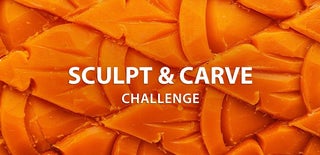Introduction: Cast Your Own Metal Props & Findings With DIY Carving Wax and Plaster Molds
Please consider subscribing to my YouTube channel for more projects
Hello fellow makers,
In this Instructable I would like to show you guys one of the ways I use to make my own small molds to cast metal or resin out of machining/carving wax.
I use this method if I require something with more detail and accuracy than what a fdm 3D printer could provide and also just for things that you want to have that unique hand carved touch.
Another bonus is that using machining wax to create molds require very little cutting power which is perfect for high quality results even on small desktop CNC's and the new breed of 3 in 1 3D printers.
This time I'll be making a vintage looking button cast with tin in a plaster mold from carved wax. But if you would rather cast it in resin you can just swap out the plaster for silicon.
Let's get started...
Supplies
To replicate this Instructable you will need the following:
- Paraffin wax
OR
- Premade machining wax
- A sharp hobby knife
- Plaster of paris
- Silica sand
- Plastic disposable cups
- Old plastic shopping bags
- Sanding paper
Optional:
- Access to a CNC or a 3D printer with CNC capabilities.
- Butane torch
- Metal for casting
*As an Amazon Associate I receive a small percentage from sales made through provided links at no cost to you, this helps fund future projects.
Step 1: Making the Machinable Wax:
Because of the ridiculously high price of machinable wax I always use this great Instructable bymakewithjake
Just be really careful when making your own and if you have any doubts you could always use premade machining wax.
I used 5 parts paraffin wax to 1 part of plastic shopping bag that I cut up into small pieces this way they dissolve almost instantly into the hot wax.
Step 2: Design Your Wax Carving:
What I like to do for these types of carved pieces is to start with a good blank base.
Using Aspire I designed a simple button blank that was simply made with two circles, one 30mm that will be the size of the button and then just another 40mm circle around it that we will just pocket cut.
I used the sculpting tool to make a 15mm inverted dome in the centre and placed four 3.2mm drill holes.
This piece was designed so that a single 3.175mm 2 flute endmill can be used for the entire cut avoiding unnecessary stops and tool changes.
Step 3: Tip: Machining Wax Holders
A challenge when creating your own machining wax is to get container to mold the molten wax into that will produce square blocks.
Unfortunately most of the time you will still need to square off these blocks before using as the can shrink when cooling and your mold might not be perfectly flat
So what I started doing is to cut off the bottom ~15mm of plastic cups and then mold my wax in those, that way you you get nice self contained "pucks" and they are easily mounted to your machines work bed with some hot melt glue.
And don't throw away the top of the cups as I've got a neat trick for those too!...
Step 4: The Wax:
I make my machining wax in big slabs that I cut off chunks and remelt and pour as needed.
A neat little trick I found is if you have a 3D printer set your bed to 100 degrees and then place your plastic cup bottoms on that while pouring moulding the wax into them.
This will stop the wax from hardening and allow any air bubbles trapped inside the wax to escape, I usually leave it for about 10 minutes before turning off the bed and allowing it to solidify.
Step 5: Carving the Blank:
Now we are ready to carve the button blank.
I secured my wax puck to the machines table with some hot melt glue (and no I've never had it come loose during cutting, the forces needed for cutting the wax are minimal) and centered the bit in the middle of the wax puck.
I like to start the design with a 1mm pocket cut over the entire piece just so that we know the top of our wax puck is square to the machine.
Now go ahead and let it carve out the entire blank.
Tip: I have found that adding some cold soapy water while machining gave me much cleaner results. And it makes for easier clean-up!
Step 6: Other Designs:
I just wanted to show some other possibilities when you use multiple tool changes.
This does require more work when zeroing a manual machine like mine but I get great results by just placing a guide (I use a piece of aluminium stock) to zero your axis on.
Here I carved a Dragon Age design brooch using a 3.175mm for roughing and then a 0.1mm engraving bit for the finishing pass.
Step 7: Carve the Details:
Now using whatever tools you have at your disposal we can start carving the detail into the wax blank.
I simply used a sharp hobby knife and a long needle to get any stuck pieces of wax out, as this was a very simple design I didn't require any additional tools.
If you want to go into more detail you can have a look at these available carving tools:
And remember if you are not happy with the results you can always just remelt the wax and try again!
Step 8: The Plastic Cup Top:
Remember I told you not to throw away that leftover top, well by taking a lighter and just quickly going around the cut piece of the cup will cause it the shrink slightly.
You can now slip your carved wax puck into the cup and it will get caught at the bottom and create a perfect container to pour either your plaster or silicon over your design to create your mold.
Step 9: Mixing the Plaster:
If you will be casting resin you will replace the plaster in this step with silicone.
I mixed 1 part sand (this needs to be clean silica sand) and 4 parts plaster of paris. I didn't have anymore clean sand available when I did this Instructable but didn't matter as I wanted a antique look but impurities in the sand burn away and causes bubbles in your casting.
Mix it to the manufacturers instructions until you are left with a runny paste.
Pour in into your carving from the side of the cup so that it runs over your carving and gently tap out any trapped air bubbles.
Leave to dry.
Step 10: The Metal Casting:
With the plaster set and completely dry we can remove our wax carving, to avoid any damage to the mold I decided to bake the plaster mold in an oven (not one used for cooking) to melt away the wax.
This time in the oven also made sure that the plaster is free from any moisture that could cause it to break when casting the metal.
Next I took my butane torch and slowly heated the plaster mold, then I started adding pieces of tin into the cavity along with some flux until it was completely full heating as I go.
Then let it cool completely!
Step 11: Reveal Your Creation:
After the piece has cooled it is time to take it out of the mold, the design of the mold allowed me to simply pop it out without breaking the plaster.
If your piece is a little more stubborn simply submerge the plaster into water and break it away from your casting.
Next I flattened both sides of the button using some wetted 400 grit sandpaper and then gave it a polish with a brass brush attached to my Dremel.
Step 12: The Finishing Touches:
After polishing my button it looked way too new.
I took a permanent marker and colored over the entire button making sure I get the ink into all the nooks and crannies.
Leave it to dry for a few seconds then take a damp rag and polish away all the ink that is on the high spots so that the lower carvings are left with ink inside.
This gave it the nice aged look I was after.
Step 13: Enjoy!
I hope you guys enjoyed this Instructable and if you have any questions please feel free to leave me a message or comment bellow.
Please share your own creations with us by clicking the "I Made It" button below.
Happy making!

Runner Up in the
Sculpt & Carve Challenge













